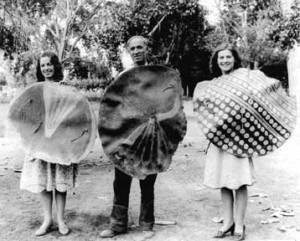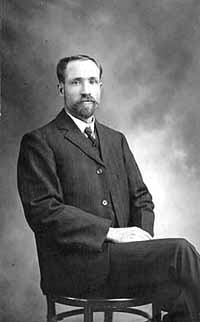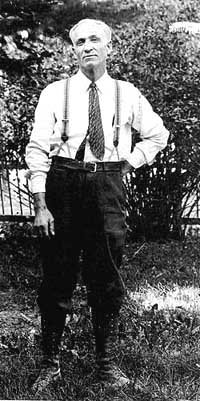E. P. Pectol
by Judy Shell Busk
“Wayne Wonderland” was his chosen name for Capitol Reef, the folds of sandstone rock that carve and curl their way down 100 miles of desert country in south-eastern Utah, creating a kaleidoscope of color as ocher, ivory, rust, lavender, gray, and yellow combine in luminous rock formations. Sheer cliffs, deep canyons, rounded domes, majestic arches, and yawning chasms all become part of the wonder.
Ephraim Portman Pectol loved this country with a passion that resulted in dedication to its preservation but also its use. As Neal Busk, explains, “Grandpa Pectol had the unique ability to see both sides of wilderness issues: loving a land and desiring to safeguard it but also wanting to exploit its economic potential.” He adds, “Wayne County was a poor area. People had a hard time making a living, but Grandpa wanted to live there. He also wanted people to come and see the land’s beauty and appreciate it, to feel the same kind of love for the country that he had.”
Busk carries his grandpa’s middle name, Portman, and his sentiments as well: “The same struggle exists today. The industrialization and commercialization of the scenic beauties of the west is almost a contradiction. So the question becomes how to have people experience the beauty of the land without engendering tourist sprawl. How do you give economic viability to the area without destroying valued life styles?”
Historically, where and when did Port Pectol’s romance–which it really was–with Capitol Reef begin?
It began partially with Dorothy Delilah Hickman in the early 1880s when she was about twelve years old and he was sixteen. Port, characterizing himself as his family’s “official cow herder” recalls first meeting Dot in Caineville: “While driving the cows past a farm house late one afternoon, I saw two girls turning somersaults on a straw shed. Riding over, I found their names to be Dorothy Delilah Hickman and Romania Carrell. . . . Dot had come with her parents . . . on a visit. A few years later, they again returned. I met them on the Blue Dugway as they came in. Dot was no longer a pug nose kid. She had grown up and been promoted to my class age. As I sat on my horse, looking into her eyes, I knew that some day she would be my wife.”
A subsequent friendship and courtship led to marriage in 1899. Over the next eight years four daughters were born to the couple as Port struggled economically doing everything from living with relatives, to selling Singer sewing machines, to teaching school to survive. In the spring of 1906, the couple moved to Caineville, where Port had been elected county superintendent of schools and had a contract to teach as well.
In early August of 1906 Port was called by the Mormon Church to “take a mission to the New Zealand islands.” He was to teach Maori children. Port advised then Mormon Church president, Joseph F. Smith, that he “would be ready in August 1907, I having to complete my un-expired term of County School Superintendent and to fill contract of teaching in Caineville District School.”
Port’s absence from his beloved Dottie for two and one-half years was wrenching to them both as their extensive diary entries and letters reveal. Out of the experience, however, they developed an increased love. Also Dot developed her economic independence as she supervised a farm, took in boarders, did bee keeping, ran the post office, and had a Sears catalogue business. She also experienced the heavy demands of raising the four children, ages seventeen months to seven years old when Port left–nursing them through epidemic measles at one point.
When Port returned from New Zealand, Christmas Eve of 1909, he was faced again with the responsibility of earning a living. The devasting floods in the fall of 1909 had destroyed any Caineville potential. The Pectols sold their property there and purchased land in Grover and Teasdale. One-thousand dollars from the subsequent sale of this property was applied toward the purchase price of a general store in Torrey in 1910.
The store’s name was changed to “The Wayne Umpire” about 1912. The Pectols operated the store until 1944. Dot’s experiences while Port was on his LDS mission developed skills she used in running the store. Fontella, the fourth daughter, in a memoir described her mother: “There was no limit to her strength, energy, and ability. If she had not been at the helm of the Pectol Raft, it would have capsized more times than one. She was an expert in managing and organizing her home and the store.” Fontella added, “My mother was independent and efficient all her life. If she wanted a piano moved, she moved it; if she needed wood to keep the house warm, she chopped it; if she needed a ditch dug to water her garden, she dug it. She could take down a wall in the house, or build a new one.”
Dot’s independence and management skills in running the store allowed Port to pursue the vocation of teaching periodically, as well as serve as bishop of the Torrey LDS ward for sixteen years. He also avidly pursued an avocation: searching for Indian artifacts, this at a time when no stigma was attached to exploring ancient cultures in this way. He amassed a collection of hundreds of items, many of which were displayed in a “museum” above his Torrey general store. Here he proudly showed visitors decorated pottery bowls, woven baskets, digging sticks, moccasins and other clothing items, projectile points, and other implements.
Pectol’s most spectacular find was three buffalo hide shields, the largest ever found in North America. The discovery is interlaced with mystical significance. In Pectol’s own words:
“On August 16, 1926, Sister Pectol and I decided to make a search for cliff dwellings near our home in Torrey, Utah. . . . Just as the shades of evening were falling, we decided to return home, and, rounding a large rock, we passed by the mouth of a cave, perhaps 30 feet long and 13 feet wide, and 4 feet high. The wife suggested that I dig in this cave before passing it up, which I did rather reluctantly. I discovered that something was buried as I came to a cover apparently of some sort of rawhide. We decided to let our children see what might be buried . . . . We went home, got our kiddies in the car; and three men who were assisting in building our meeting house decided to go back with us. We returned, built a bonfire in front of the cave, and at 10 o’clock at night we unearthed three of the most wonderful shields ever seen by man. As we raised the front shield, the design on two shields came to view. For the space of what seemed to me two or three minutes, no one seemed to breathe; we were so astonished. We felt we were in the presence of the one who had buried the shields . . . .”

Pectol and daughters Golda and Devona hold three Buffalo hide shields - Photo courtesy BYU Museum of Peoples and Cultures
Because of his belief in The Book of Mormon, a Church of Jesus Christ of Latter-day Saints sacred book, which gives a religious and historical account of a people who lived on the American continent long before the Europeans discovered its existence, the shields took on additional significance to Pectol. He interpreted their designs as representing creation, the peopling of the earth, and the conflict between good and evil. Port’s fifth daughter, Golda, born two years after his return from New Zealand, always spoke of the unveiling of the shields in hushed tones with reverence, commenting on the spirituality she felt as the shield’s designs were revealed in the flickering firelight.
Port’s almost poetic writings on other archaeological finds reveal his sense of spiritual connection to Native American peoples. Commenting on the discovery of old fortresses he writes, “The myriads of broken arrow points in and around these forts, and the valley between strewn with hundreds of graves, tells its own gruesome story of how two mighty opposing forces once fought for possession no doubt of this land. How perhaps for weeks the battle raged. We picture women and children under cover of darkness carrying food and water to the entrenched braves . . . . At last the entrenched army, seeing defeat at hand, demolished everything of value to the foe, and under cover of darkness retreats to the south-west carrying with them whatever belongings remained, bidding good-bye as they passed their homes nestled among the cliffs.”
Convinced that Capitol Reef needed to be preserved, not only for its scenic beauty but also for its Native American significance, Port Pectol worked with his wife’s brother, Joseph Hickman, to get the area set aside as a state park. Hickman, a Utah State legislator, convinced fellow legislators to set aside 160 acres at Fruita as a state park. Dedication ceremonies were held July 20, 1925. Four days after this celebration, Hickman was drowned in a storm at nearby Fish Lake. Port Pectol continued advocacy of the park as president of the new Civics Club; and when he was elected to the legislature in 1933, he worked tirelessly until the area was made a National Monument in 1937. Park ranger Robert Munk recently described Hickman and Pectol as “common men with uncommon vision for the time.” The monument was expanded in 1958 and 1969, and Capitol Reef became a National Park in 1972.
To learn more about E.P. Pectol visit the Museum of Peoples and Cultures at Brigham Young University. http://fhss.byu.edu/anthro/mopc/main.htm




